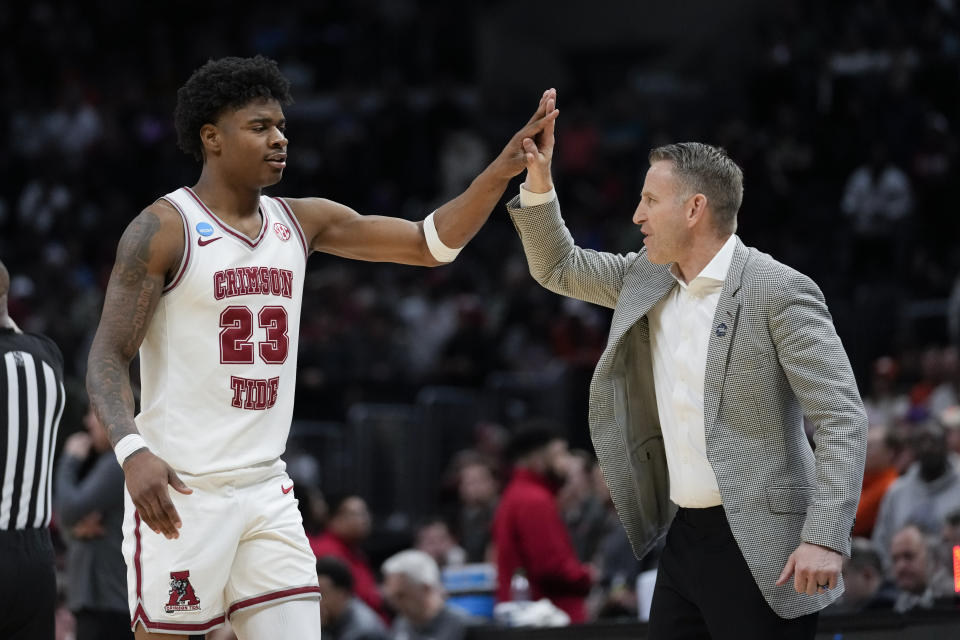A look at each men's Final Four team, through advanced stats
It feels like UConn vs. the field in the men's Final Four, and the advanced stats show the defending champions have no glaring weaknesses.
Still, the other three teams made it this far for a reason. Here's a look at what each Final Four participant does well and what it doesn't, with some help from Ken Pomeroy's numbers.
UCONN (35-3)
Pomeroy Rank: 1
Strengths: Where do you begin? In 2-point field goal percentage, UConn is No. 4 in the country on offense and No. 2 on defense. If you think you can make up for that by making a lot of 3s, the Huskies are pretty good at limiting attempts from beyond the arc. They also don't turn the ball over that much, and they're No. 13 in Division I in offensive rebounding percentage. So you're probably not going to make up ground in those areas if you're behind in shooting percentage.
Weaknesses: The Huskies are only 315th in adjusted tempo. So you can play a low-possession game against them and try to pull off the upset that way.
In This Tournament: The best example of UConn's dominance came in the Elite Eight, when the Huskies shot 3 of 17 from 3-point range and still beat Illinois by 25. UConn shot 28 of 43 from 2-point range while the Illini went 11 of 44.
PURDUE (33-4)
Pomeroy Rank: 3
Strengths: Led by 7-foot-4 Zach Edey, the Boilermakers are dominant on the boards, ranking sixth in the country in offensive rebound percentage. They're also ninth in free throw rate and second in 3-point shooting percentage.
Weaknesses: Purdue is the most turnover-prone team at the Final Four, and the Boilermakers don't force many themselves. They could be vulnerable to a hot-shooting opponent.
In This Tournament: Purdue had an uncharacteristically poor outside shooting day in the regional final against Tennessee, getting outscored 33-9 beyond the arc. The Boilermakers made up for that by attempting 33 free throws to 11 for the Volunteers, and they had 13 offensive rebounds to Tennessee's six.
ALABAMA (25-11)
Pomeroy Rank: 12
Strengths: It'll be a contrast in style against UConn, with the Crimson Tide ranking ninth in adjusted tempo. They shoot a lot of 3s, and they hit the offensive boards well. Alabama doesn't get to the line as well as, say, Purdue, but the Crimson Tide shoot a better percentage from there than any other team remaining.
Weaknesses: Defense, defense and defense. Alabama is 104th in adjusted defensive efficiency. Pomeroy's stats go back to 1997, and the worst defensive team to win a title in that span was Baylor in 2021, which finished at No. 22.
In This Tournament: Alabama's 109-96 win over Charleston in the first round was a good reflection of what this team is. The second round against Grand Canyon was a helter-skelter game in which scoring was down, but then the Crimson Tide reverted to form, beating North Carolina and Clemson while allowing over 80 points but scoring enough to win.
NORTH CAROLINA STATE (26-14)
Pomeroy Rank: 43
Strengths: The Wolfpack take care of the ball, ranking ninth in the country in turnover percentage. That means even if the team is going through a rough stretch offensively, they don't compound their problems, and they've been able to avoid falling too far behind.
Weaknesses: Even after this run through the ACC Tournament and its NCAA regional, N.C. State is pretty average in many statistical categories. The Wolfpack don't rely much on the 3, so if an opponent can defend big man DJ Burns one on one, they may be in trouble.
In This Tournament: Burns is shooting 67% from the field through four games. Thanks to that, the Wolfpack have shot over 50% from 2-point range in each game. They've gotten some good fortune too, with Marquette and Duke combining to go 9 of 51 from 3-point range.
___
AP March Madness bracket: https://apnews.com/hub/ncaa-mens-bracket and coverage: https://apnews.com/hub/march-madness





